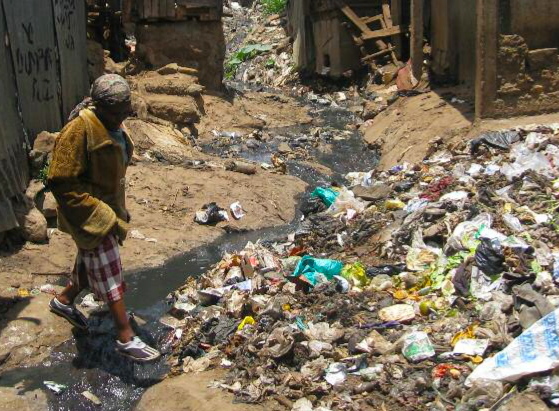#6: Sanitation struggles for women in Nairobi
World Toilet Day came and went, but the global sanitation issue still remains ever-present. Issues of inadequate sanitation are most prominent in urban areas (Govender et al., 2011); in Africa, where 1 in 7 individuals live in urban slums, public toilet and bathing facilities are frequently lacking in their quality and quantity.
For this post, I will explore how women are particularly disadvantaged by poor quality sanitation facilities. Whilst many credible journals detail the nexus between poor sanitation and women’s development, I’m focusing on a study of slums in Nairobi, Kenya conducted by Amnesty International that interviewed female slum dwellers directly on their experience of using sanitation facilities. Whilst this post is not exhaustive of the many sanitation-related issues that women face, illuminating the lived experiences of women is one way in which their sanitation needs will be exemplified.
Figure 1: Faeces disposal in a slum in Nairobi
Source: Amnesty International Report
In Nairobi, 68% of slum dwellers rely on shared toilet/latrine facilities which are “rarely in a hygienic and clean condition” and around 6% of slum dwellers lack access to any toilet facilities (Figure 1). A lack of adequate sanitation evidently results in a high incidence of disease and infections, disadvantaging the entire slum population. For women, health risks associated with water collection, as indicated in my previous posts, coupled with a higher risk of infection from poor sanitation means women have greater exposure to disease. The stats confirm this reality with a 2011-2013 study in the Mathare slums in Kenya revealing that men were 17% more likely to have good health as compared to women (Corburn and Hildebrand, 2015).
In addition to health issues, a lack of adequate sanitation harms women’s security and their right to freedom from gender-based violence. Women habituating these slums pointed out they must travel extremely long distances of more than 300 metres to reach public toilet and bathing facilities. This journey heightens the increased risk of sexual violence and harassment for women, especially during the night (Winter and Barchi, 2015). Women explained how girls had experienced harrowing instances of rape and other forms of sexual violence. Another study conducted in Kibera, Africa’s largest slum, disclosed that over 36% of female slum dwellers were physically forced to have sex as compared to 14% of all Kenyan women with relation to their use of toilets (Corburn and Hildebrand, 2015). Often, gender-based violence is ignored, men are left unpunished, yet women remain without freedom, agency and power (ibid).
To protect their own safety, women explained how they would prioritise using toilets earlier in the day. However, women hold responsibilities within their families, as carers, water collectors and as local market workers thus disruption to their schedule influences their entire socioeconomic life. Often to avoid these burdens associated with toilet use, women might drink less fluid which leads to dehydration, urinary tract infections and gastric disorders.
Moreover, women in Nairobi expressed their shame and feelings of indecency surrounding toilet use. On average, one toilet or pit latrine is shared with up to 50 people leading to lengthy queues and restricted privacy especially as doors and locks are often missing (Khosla, 2000). As a result, these women sometimes choose to defecate in the open but are met with indecent remarks and sexual threats. Sometimes, women are forced to use unhygienic means of “flying toilets” where human waste would be disposed of in plastic bags thrown into the open due to the absence of adequate safe toilets. Bathing facilities are also shared by tens and thousands, so women often opt to shower in their houses. This poses further issues of shame and immorality as women are forced to bathe in front of their families. Considering Amartya Sen’s definition of development, issues of inadequate sanitation not only is a danger for women’s physical health wellbeing but also increases their social marginalisation, restriction of freedoms and anxiety.
To conclude, I have highlighted only some of the issues that women in developing nations, such as in slums of Nairobi, may face when simply using the toilet or bathing. Notably, I referenced Amartya Sen’s definition of development because for women, using the toilet is not just a public health or infrastructural issue but also a matter of personal safety directly hindering their social development. These forms of uneven social development prevent women from expanding their freedom, capabilities and opportunities (Sen, 1999).


A really informative blog post Sophia! I especially liked your use of Nairobi to illustrate sanitation issues how much it affects a woman’s life. I really liked your statistical comparisons between men and women to support this.
ReplyDeleteThank you Laila, the statistical comparison is quite shocking.
DeleteVery intersting choice of case study to reveal the struggles for women. I like how you've applied Sen's capabilities approach to frame these issues and look forward to seeing you expand on this in your next post!
ReplyDeleteThank you Hamnah.
Delete